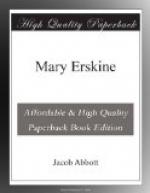From this time forward, although Mary Erskine was more diligent and faithful than ever in performing all her duties at Mrs. Bell’s, her imagination was incessantly occupied with pictures and images of the new scenes into which she was about to be ushered as the mistress of her own independent household and home. She made out lists, mentally, for she could not write, of the articles which it would be best to purchase. She formed and matured in her own mind all her house-keeping plans. She pictured to herself the scene which the interior of her dwelling would present in cold and stormy winter evenings, while she was knitting at one side of the fire, and Albert was busy at some ingenious workmanship, on the other; or thought of the beautiful prospect which she should enjoy in the spring and summer following; when fields of waving grain, rich with promises of plenty and of wealth, would extend in every direction around her dwelling. She cherished, in a word, the brightest anticipations of happiness.
[Illustration: The log house.]
The house at length was finished. The necessary furniture which Albert contrived in some way to get moved to it, was put in; and early in August Mary Erskine was married. She was married in the morning, and a party of the villagers escorted her on horseback to her new home.
CHAPTER III.
Mary Erskine’s visitors.
Mary Erskine’s anticipations of happiness in being the mistress of her own independent home were very high, but they were more than realized.
The place which had been chosen for the house was not only a suitable one in respect to convenience, but it was a very pleasant one. It was near the brook which, as has already been said, came cascading down from among the forests and mountains, and passing along near one side of Albert’s clearing, flowed across the road, and finally emptied into the great stream. The house was placed near the brook, in order that Albert might have a watering-place at hand for his horses and cattle when he should have stocked his farm. In felling the forest Albert left a fringe of trees along the banks of the brook, that it might be cool and shady there when the cattle went down to drink. There was a spring of pure cold water boiling up from beneath some rocks not far from the brook, on the side toward the clearing. The water from this spring flowed down along a little mossy dell, until it reached the brook. The bed over which this little rivulet flowed was stony, and yet no stones were to be seen. They all had the appearance of rounded tufts of soft green moss, so completely were they all covered and hidden by the beautiful verdure.
Albert was very much pleased when he discovered this spring, and traced its little mossy rivulet down to the brook. He thought that Mary Erskine would like it. So he avoided cutting down any of the trees from the dell, or from around the spring, and in cutting down those which grew near it, he took care to make them fall away from the dell, so that in burning they should not injure the trees which he wished to save. Thus that part of the wood which shaded and sheltered the spring and the dell, escaped the fire.




